KIA SEDONA 2018 Owners Manual
Manufacturer: KIA, Model Year: 2018, Model line: SEDONA, Model: KIA SEDONA 2018Pages: 586, PDF Size: 14.1 MB
Page 571 of 586
![KIA SEDONA 2018 Owners Manual 48
TIRES AND WHEELS Specifications & Consumer information
ItemTire size Wheel sizee Inflation pressure [kPa (psi)]
Wheel lug nut torque
Normal load *1Maximum load
Front Rear Front Rear
Full size ti KIA SEDONA 2018 Owners Manual 48
TIRES AND WHEELS Specifications & Consumer information
ItemTire size Wheel sizee Inflation pressure [kPa (psi)]
Wheel lug nut torque
Normal load *1Maximum load
Front Rear Front Rear
Full size ti](/img/2/40452/w960_40452-570.png)
48
TIRES AND WHEELS Specifications & Consumer information
ItemTire size Wheel sizee Inflation pressure [kPa (psi)]
Wheel lug nut torque
Normal load *1Maximum load
Front Rear Front Rear
Full size tire 235/65 R17 6.5J X 17 240 (35) 240 (35) 240 (35) 240 (35)
9 ~ 11
(65 ~ 79, 88 ~ 107)
235/60 R18 7.0J X 18 240 (35) 240 (35) 240 (35) 240 (35)
235/55 R19 7.5J X 19 240 (35) 240 (35) 240 (35) 240 (35)
Compact spare tire T135/90 R17 4.0T X 17 420 (60) 420 (60) 420 (60) 420 (60)
CAUTION
When replacing tires, use the same size originally supplied with the vehicle. Using tires of a different size can damage the related parts or make it work irregularly.
*1 : Normal load : Up to 3 persons
✽ ✽ NOTICE
• It is permissible to add 21 kPa (3 psi) to the standard tire pressure specification if colder temperatures are expect-
ed soon. Tires typically loose 7 kPa (1 psi) for every -11°C (12°F) temperature drop.
If extreme temperature variations are expected, re-check your tire pressure as necessary to keep them properly
inflated.
• We recommend that when replacing tires, use the same originally supplied with the vehicles. If not, that aff\
ects driving performance.
• When driving in high altitude grades, it is natural for the atmospheric pressure to decrease. Therefore, please check the tire pressure and add more air when necessary.
Additionally required tire air pressure per km above sea level: 10.5 kPa (1.5 psi)/km
Page 572 of 586
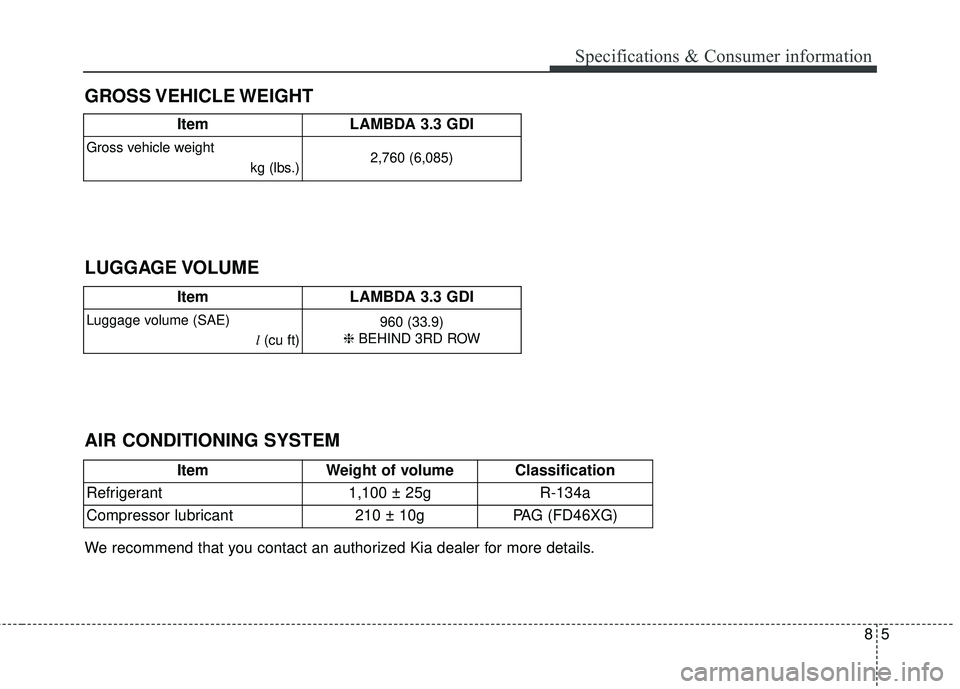
85
GROSS VEHICLE WEIGHTSpecifications & Consumer information
Item
LAMBDA 3.3 GDI
Gross vehicle weight
kg (lbs.)2,760 (6,085)
AIR CONDITIONING SYSTEM LUGGAGE VOLUME
ItemWeight of volume Classification
Refrigerant
1,100 ± 25g R-134a
Compressor lubricant
210 ± 10g PAG (FD46XG)
We recommend that you contact an authorized Kia dealer for more details.Item LAMBDA 3.3 GDI
Luggage volume (SAE)
l(cu ft) 960 (33.9)
❈ BEHIND 3RD ROW
Page 573 of 586
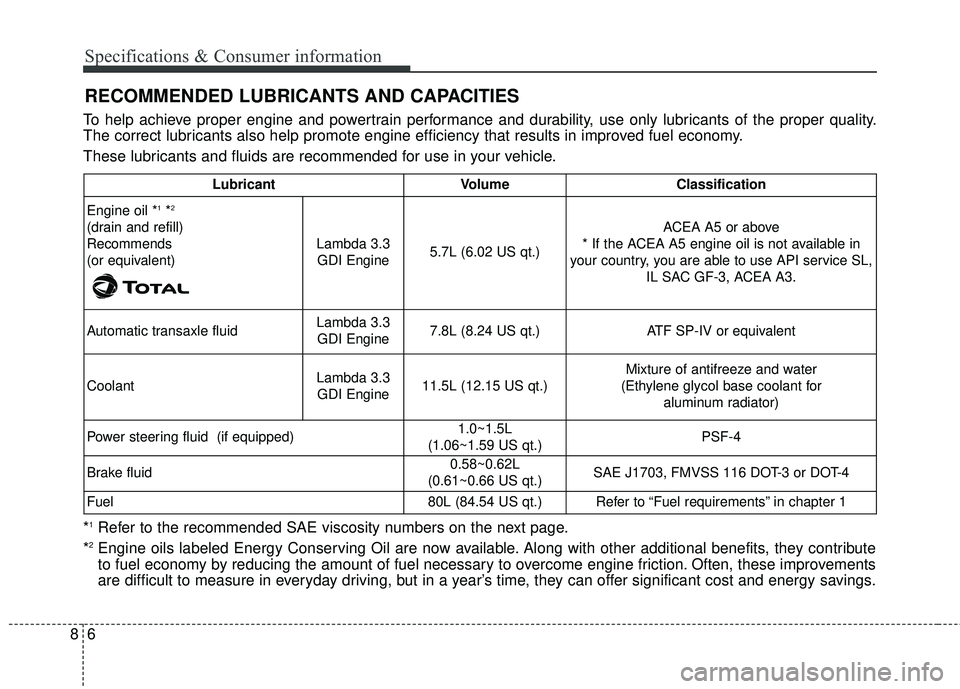
68
Specifications & Consumer information
RECOMMENDED LUBRICANTS AND CAPACITIES
To help achieve proper engine and powertrain performance and durability, use only lubricants of the proper quality.
The correct lubricants also help promote engine efficiency that results in improved fuel economy.
These lubricants and fluids are recommended for use in your vehicle.
*
1Refer to the recommended SAE viscosity numbers on the next page.
*2Engine oils labeled Energy Conserving Oil are now available. Along with other additional benefits, they contribute
to fuel economy by reducing the amount of fuel necessary to overcome engine friction. Often, these improvements
are difficult to measure in everyday driving, but in a year’s time, they can offer significant cost and energy savings.
Lubricant Volume Classification
Engine oil *
1*2
(drain and refill)
Recommends
(or equivalent) Lambda 3.3
GDI Engine 5.7L (6.02 US qt.) ACEA A5 or above
* If the ACEA A5 engine oil is not available in
your country, you are able to use API service SL, IL SAC GF-3, ACEA A3.
Automatic transaxle fluid Lambda 3.3
GDI Engine 7.8L (8.24 US qt.) ATF SP-IV or equivalent
Coolant Lambda 3.3
GDI Engine 11.5L (12.15 US qt.) Mixture of antifreeze and water
(Ethylene glycol base coolant for aluminum radiator)
Power steering fluid (if equipped) 1.0~1.5L
(1.06~1.59 US qt.) PSF-4
Brake fluid 0.58~0.62L
(0.61~0.66 US qt.) SAE J1703, FMVSS 116 DOT-3 or DOT-4
Fuel 80L (84.54 US qt.) Refer to “Fuel requirements” in chapter 1
Page 574 of 586
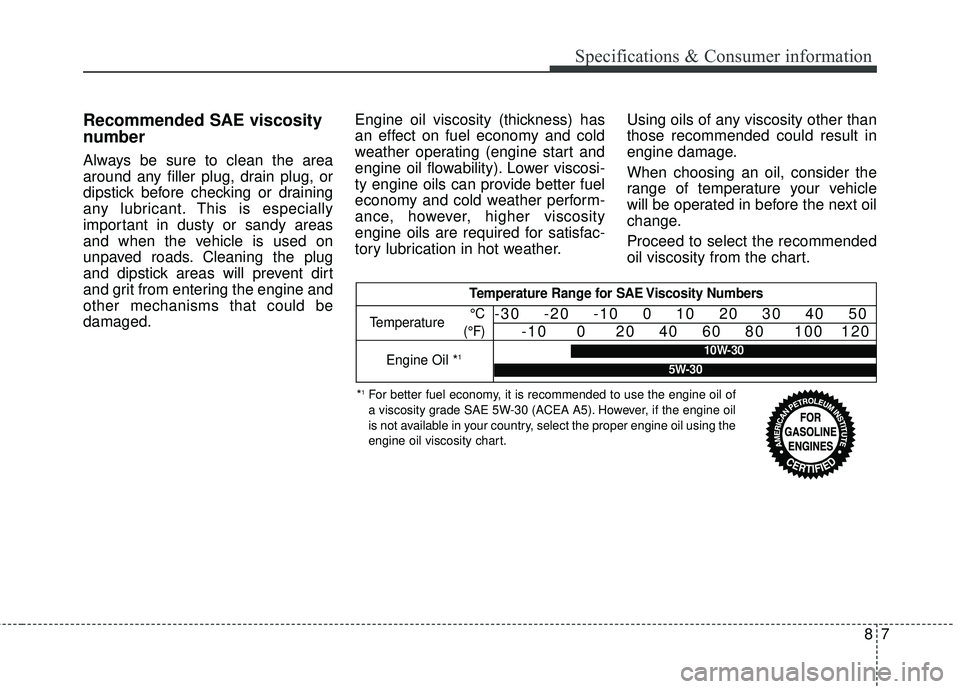
Recommended SAE viscosity
number
Always be sure to clean the area
around any filler plug, drain plug, or
dipstick before checking or draining
any lubricant. This is especially
important in dusty or sandy areas
and when the vehicle is used on
unpaved roads. Cleaning the plug
and dipstick areas will prevent dirt
and grit from entering the engine and
other mechanisms that could be
damaged.Engine oil viscosity (thickness) has
an effect on fuel economy and cold
weather operating (engine start and
engine oil flowability). Lower viscosi-
ty engine oils can provide better fuel
economy and cold weather perform-
ance, however, higher viscosity
engine oils are required for satisfac-
tory lubrication in hot weather.
Using oils of any viscosity other than
those recommended could result in
engine damage.
When choosing an oil, consider the
range of temperature your vehicle
will be operated in before the next oil
change.
Proceed to select the recommended
oil viscosity from the chart.
Temperature Range for SAE Viscosity Numbers
Temperature
Engine Oil *
1
°C
(°F)-30 -20 -10 0 10 20 30 40 50 -10 0 20 40 60 80 100 120
*1For better fuel economy, it is recommended to use the engine oil of
a viscosity grade SAE 5W-30 (ACEA A5). However, if the engine oil
is not available in your country, select the proper engine oil using the
engine oil viscosity chart.
10W-30
5W-30
87
Specifications & Consumer information
Page 575 of 586
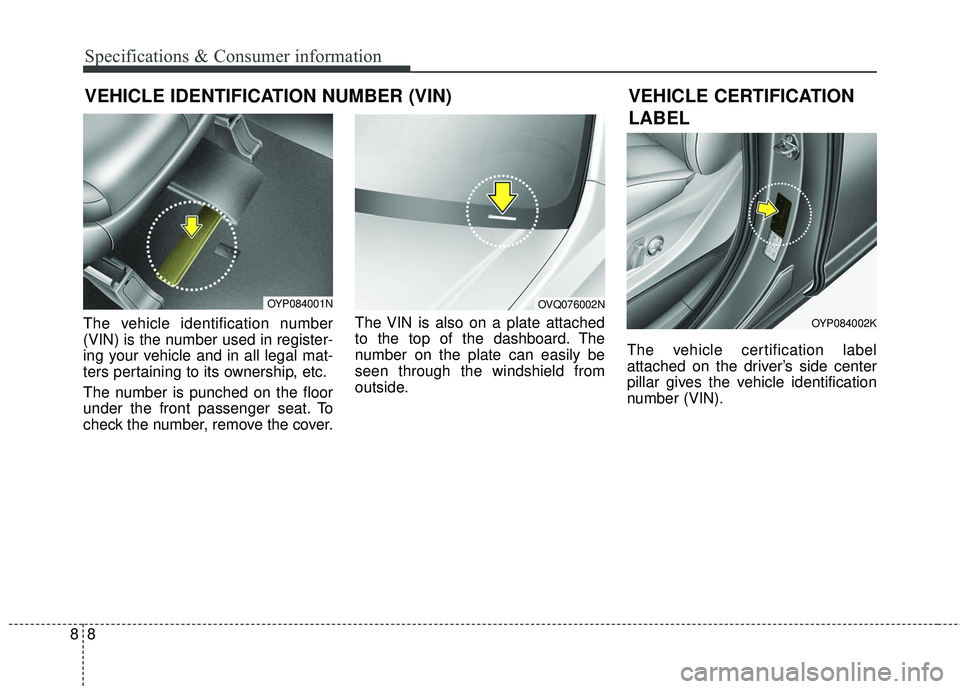
88
Specifications & Consumer information
VEHICLE IDENTIFICATION NUMBER (VIN)
The vehicle identification number
(VIN) is the number used in register-
ing your vehicle and in all legal mat-
ters pertaining to its ownership, etc.
The number is punched on the floor
under the front passenger seat. To
check the number, remove the cover.The VIN is also on a plate attached
to the top of the dashboard. The
number on the plate can easily be
seen through the windshield from
outside.
The vehicle certification label
attached on the driver’s side center
pillar gives the vehicle identification
number (VIN).
OYP084001NOVQ076002N
VEHICLE CERTIFICATION
LABEL
OYP084002K
Page 576 of 586
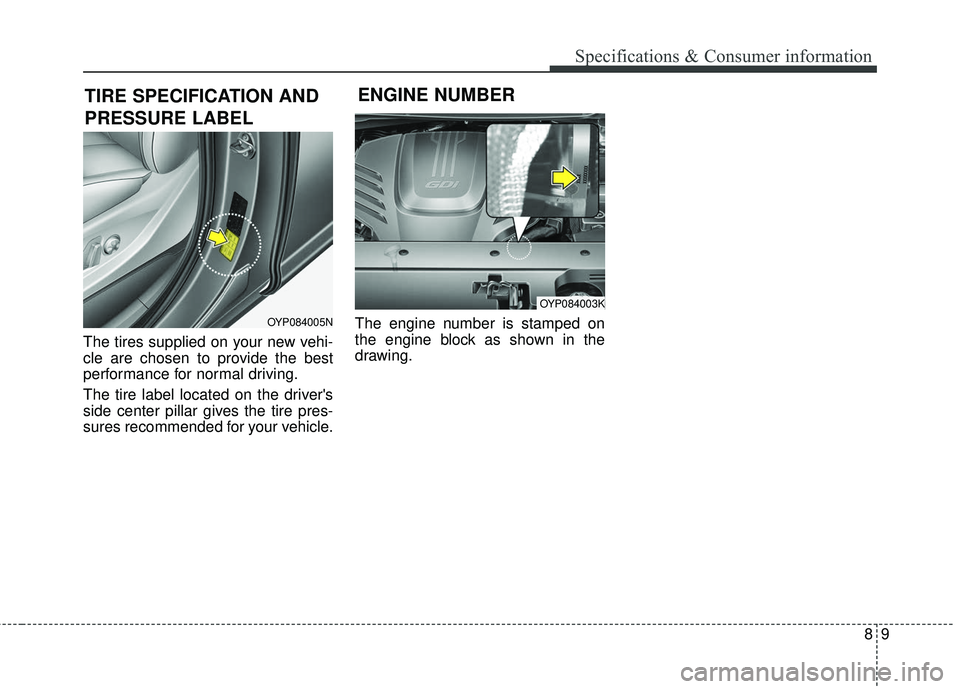
89
Specifications & Consumer information
The tires supplied on your new vehi-
cle are chosen to provide the best
performance for normal driving.
The tire label located on the driver's
side center pillar gives the tire pres-
sures recommended for your vehicle.The engine number is stamped on
the engine block as shown in the
drawing.
ENGINE NUMBER
OYP084005N
TIRE SPECIFICATION AND
PRESSURE LABEL
OYP084003K
Page 577 of 586
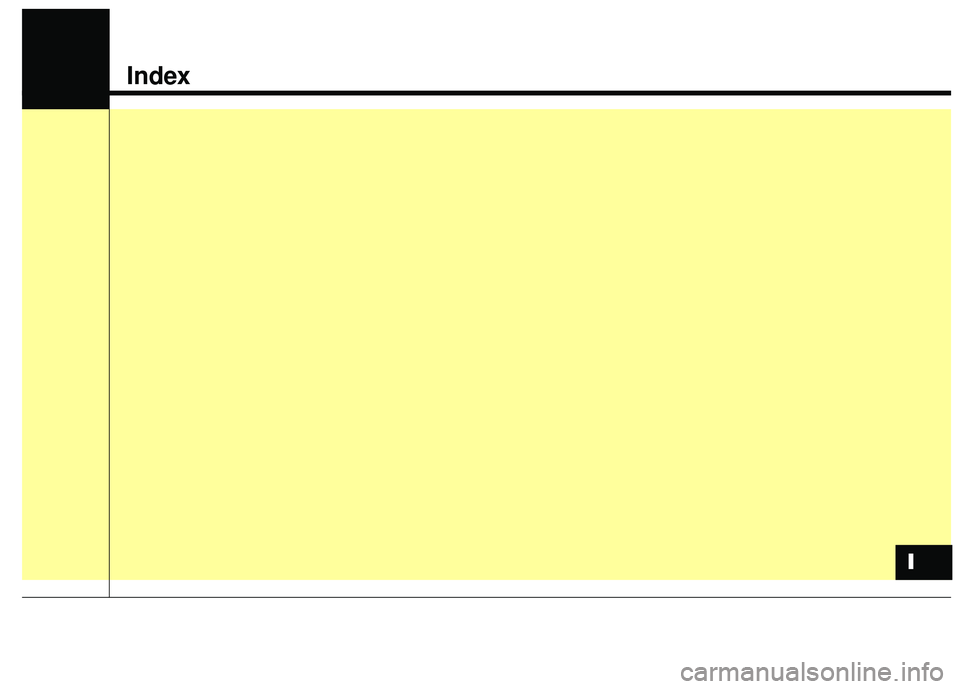
Index
I
Page 578 of 586
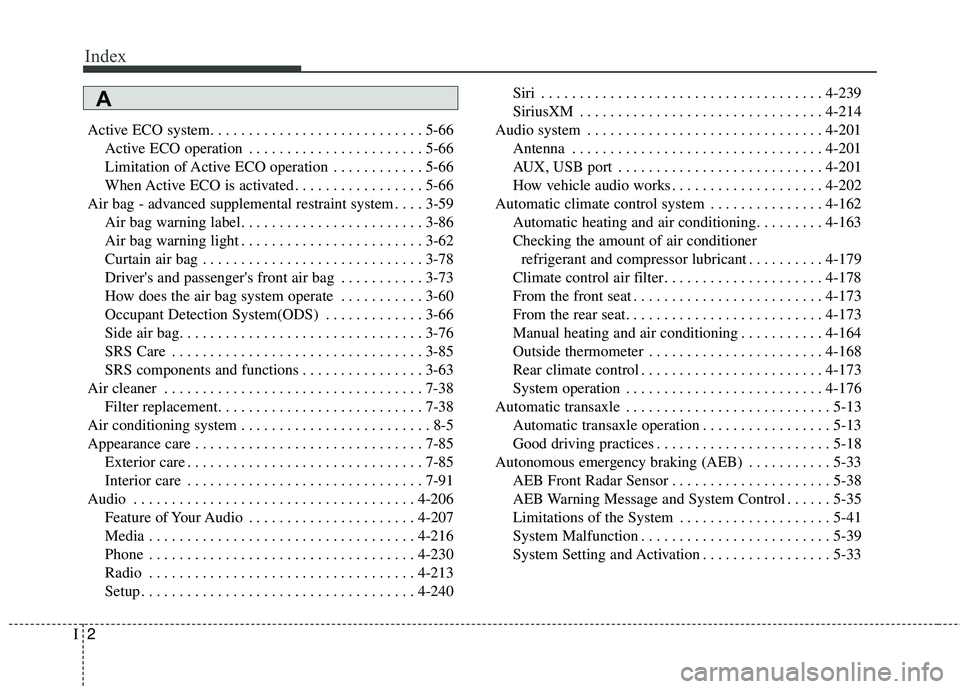
Index
2I
Active ECO system. . . . . . . . . . . . . . . . . . . . . . . . . . . . 5-66Active ECO operation . . . . . . . . . . . . . . . . . . . . . . . 5-66
Limitation of Active ECO operation . . . . . . . . . . . . 5-66
When Active ECO is activated . . . . . . . . . . . . . . . . . 5-66
Air bag - advanced supplemental restraint system . . . . 3-59 Air bag warning label. . . . . . . . . . . . . . . . . . . . . . . . 3-86
Air bag warning light . . . . . . . . . . . . . . . . . . . . . . . . 3-62
Curtain air bag . . . . . . . . . . . . . . . . . . . . . . . . . . . . . 3-78
Driver's and passenger's front air bag . . . . . . . . . . . 3-73
How does the air bag system operate . . . . . . . . . . . 3-60
Occupant Detection System(ODS) . . . . . . . . . . . . . 3-66
Side air bag. . . . . . . . . . . . . . . . . . . . . . . . . . . . . . . . 3-76
SRS Care . . . . . . . . . . . . . . . . . . . . . . . . . . . . . . . . . 3-85
SRS components and functions . . . . . . . . . . . . . . . . 3-63
Air cleaner . . . . . . . . . . . . . . . . . . . . . . . . . . . . . . . . . . 7-38\
Filter replacement. . . . . . . . . . . . . . . . . . . . . . . . . . . 7-38
Air conditioning system . . . . . . . . . . . . . . . . . . . . . . . . . 8-5
Appearance care . . . . . . . . . . . . . . . . . . . . . . . . . . . . . . 7-85 Exterior care . . . . . . . . . . . . . . . . . . . . . . . . . . . . . . . 7-85
Interior care . . . . . . . . . . . . . . . . . . . . . . . . . . . . . . . 7-91
Audio . . . . . . . . . . . . . . . . . . . . . . . . . . . . . . . . . . . . \
. 4-206 Feature of Your Audio . . . . . . . . . . . . . . . . . . . . . . 4-207
Media . . . . . . . . . . . . . . . . . . . . . . . . . . . . . . . . . . . 4-\
216
Phone . . . . . . . . . . . . . . . . . . . . . . . . . . . . . . . . . . . 4-\
230
Radio . . . . . . . . . . . . . . . . . . . . . . . . . . . . . . . . . . . 4-\
213
Setup . . . . . . . . . . . . . . . . . . . . . . . . . . . . . . . . . . . . \
4-240 Siri . . . . . . . . . . . . . . . . . . . . . . . . . . . . . . . . . . . . \
. 4-239
SiriusXM . . . . . . . . . . . . . . . . . . . . . . . . . . . . . . . . 4-214
Audio system . . . . . . . . . . . . . . . . . . . . . . . . . . . . . . . 4-201 Antenna . . . . . . . . . . . . . . . . . . . . . . . . . . . . . . . . . 4-201
AUX, USB port . . . . . . . . . . . . . . . . . . . . . . . . . . . 4-201
How vehicle audio works . . . . . . . . . . . . . . . . . . . . 4-202
Automatic climate control system . . . . . . . . . . . . . . . 4-162 Automatic heating and air conditioning. . . . . . . . . 4-163
Checking the amount of air conditionerrefrigerant and compressor lubricant . . . . . . . . . . 4-179
Climate control air filter. . . . . . . . . . . . . . . . . . . . . 4-178
From the front seat . . . . . . . . . . . . . . . . . . . . . . . . . 4-173
From the rear seat. . . . . . . . . . . . . . . . . . . . . . . . . . 4-173
Manual heating and air conditioning . . . . . . . . . . . 4-164
Outside thermometer . . . . . . . . . . . . . . . . . . . . . . . 4-168
Rear climate control . . . . . . . . . . . . . . . . . . . . . . . . 4-173
System operation . . . . . . . . . . . . . . . . . . . . . . . . . . 4-176
Automatic transaxle . . . . . . . . . . . . . . . . . . . . . . . . . . . 5-13 Automatic transaxle operation . . . . . . . . . . . . . . . . . 5-13
Good driving practices . . . . . . . . . . . . . . . . . . . . . . . 5-18
Autonomous emergency braking (AEB) . . . . . . . . . . . 5-33 AEB Front Radar Sensor . . . . . . . . . . . . . . . . . . . . . 5-38
AEB Warning Message and System Control . . . . . . 5-35
Limitations of the System . . . . . . . . . . . . . . . . . . . . 5-41
System Malfunction . . . . . . . . . . . . . . . . . . . . . . . . . 5-39
System Setting and Activation . . . . . . . . . . . . . . . . . 5-33
A
Page 579 of 586
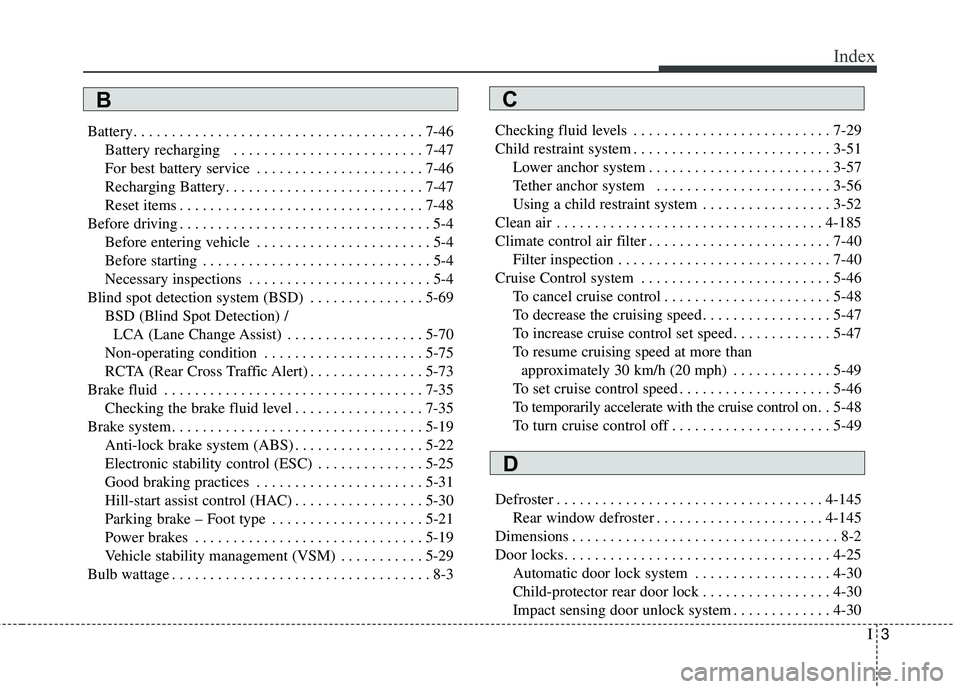
I3
Index
Battery. . . . . . . . . . . . . . . . . . . . . . . . . . . . . . . . . . . . \
. . 7-46Battery recharging . . . . . . . . . . . . . . . . . . . . . . . . . 7-47
For best battery service . . . . . . . . . . . . . . . . . . . . . . 7-46
Recharging Battery. . . . . . . . . . . . . . . . . . . . . . . . . . 7-47
Reset items . . . . . . . . . . . . . . . . . . . . . . . . . . . . . . . . 7-48
Before driving . . . . . . . . . . . . . . . . . . . . . . . . . . . . . . . . . 5-4 Before entering vehicle . . . . . . . . . . . . . . . . . . . . . . . 5-4
Before starting . . . . . . . . . . . . . . . . . . . . . . . . . . . . . . 5-4
Necessary inspections . . . . . . . . . . . . . . . . . . . . . . . . 5-4
Blind spot detection system (BSD) . . . . . . . . . . . . . . . 5-69 BSD (Blind Spot Detection) /LCA (Lane Change Assist) . . . . . . . . . . . . . . . . . . 5-70
Non-operating condition . . . . . . . . . . . . . . . . . . . . . 5-75
RCTA (Rear Cross Traffic Alert) . . . . . . . . . . . . . . . 5-73
Brake fluid . . . . . . . . . . . . . . . . . . . . . . . . . . . . . . . . . . 7-35\
Checking the brake fluid level . . . . . . . . . . . . . . . . . 7-35
Brake system. . . . . . . . . . . . . . . . . . . . . . . . . . . . . . . . . 5-19 Anti-lock brake system (ABS) . . . . . . . . . . . . . . . . . 5-22
Electronic stability control (ESC) . . . . . . . . . . . . . . 5-25
Good braking practices . . . . . . . . . . . . . . . . . . . . . . 5-31
Hill-start assist control (HAC) . . . . . . . . . . . . . . . . . 5-30
Parking brake – Foot type . . . . . . . . . . . . . . . . . . . . 5-21
Power brakes . . . . . . . . . . . . . . . . . . . . . . . . . . . . . . 5-19
Vehicle stability management (VSM) . . . . . . . . . . . 5-29
Bulb wattage . . . . . . . . . . . . . . . . . . . . . . . . . . . . . . . . . . 8-3 Checking fluid levels . . . . . . . . . . . . . . . . . . . . . . . . . . 7-29
Child restraint system . . . . . . . . . . . . . . . . . . . . . . . . . . 3-51
Lower anchor system . . . . . . . . . . . . . . . . . . . . . . . . 3-57
Tether anchor system . . . . . . . . . . . . . . . . . . . . . . . 3-56
Using a child restraint system . . . . . . . . . . . . . . . . . 3-52
Clean air . . . . . . . . . . . . . . . . . . . . . . . . . . . . . . . . . . . 4-\
185
Climate control air filter . . . . . . . . . . . . . . . . . . . . . . . . 7-40 Filter inspection . . . . . . . . . . . . . . . . . . . . . . . . . . . . 7-40
Cruise Control system . . . . . . . . . . . . . . . . . . . . . . . . . 5-46 To cancel cruise control . . . . . . . . . . . . . . . . . . . . . . 5-48
To decrease the cruising speed . . . . . . . . . . . . . . . . . 5-47
To increase cruise control set speed . . . . . . . . . . . . . 5-47
To resume cruising speed at more thanapproximately 30 km/h (20 mph) . . . . . . . . . . . . . 5-49
To set cruise control speed . . . . . . . . . . . . . . . . . . . . 5-46
To temporarily accelerate with the cruise control on. . 5-48
To turn cruise control off . . . . . . . . . . . . . . . . . . . . . 5-49
Defroster . . . . . . . . . . . . . . . . . . . . . . . . . . . . . . . . . . . 4-\
145 Rear window defroster . . . . . . . . . . . . . . . . . . . . . . 4-145
Dimensions . . . . . . . . . . . . . . . . . . . . . . . . . . . . . . . . . . . 8-\
2
Door locks. . . . . . . . . . . . . . . . . . . . . . . . . . . . . . . . . . . 4-\
25 Automatic door lock system . . . . . . . . . . . . . . . . . . 4-30
Child-protector rear door lock . . . . . . . . . . . . . . . . . 4-30
Impact sensing door unlock system . . . . . . . . . . . . . 4-30
CB
D
Page 580 of 586
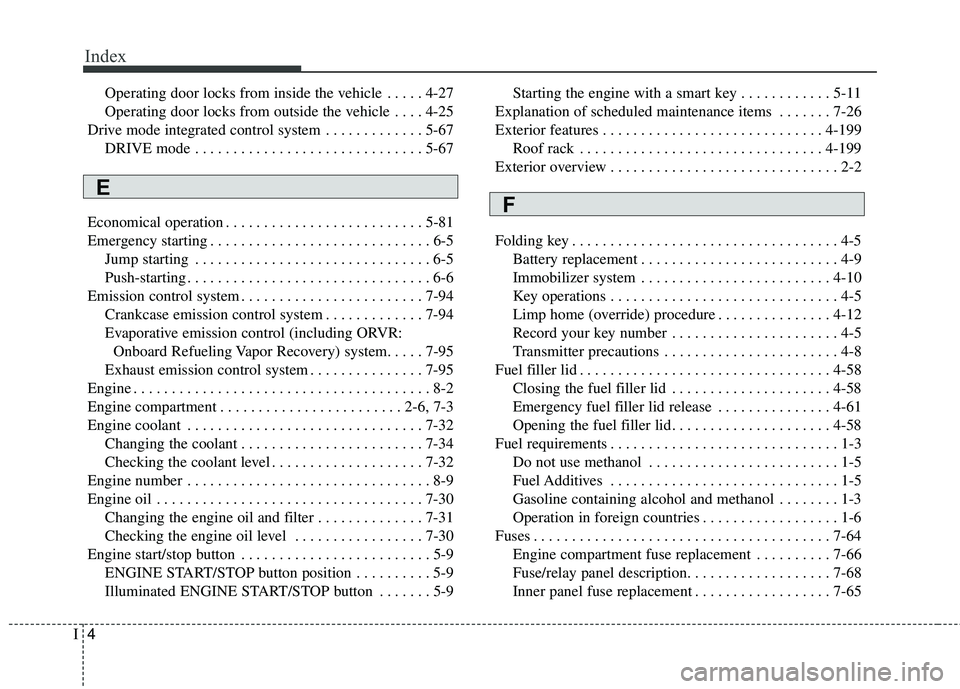
Index
4I
Operating door locks from inside the vehicle . . . . . 4-27
Operating door locks from outside the vehicle . . . . 4-25
Drive mode integrated control system . . . . . . . . . . . . . 5-67 DRIVE mode . . . . . . . . . . . . . . . . . . . . . . . . . . . . . . 5-67
Economical operation . . . . . . . . . . . . . . . . . . . . . . . . . . 5-81
Emergency starting . . . . . . . . . . . . . . . . . . . . . . . . . . . . . 6-5 Jump starting . . . . . . . . . . . . . . . . . . . . . . . . . . . . . . . 6-5
Push-starting . . . . . . . . . . . . . . . . . . . . . . . . . . . . . . . . 6-6
Emission control system . . . . . . . . . . . . . . . . . . . . . . . . 7-94 Crankcase emission control system . . . . . . . . . . . . . 7-94
Evaporative emission control (including ORVR:Onboard Refueling Vapor Recovery) system. . . . . 7-95
Exhaust emission control system . . . . . . . . . . . . . . . 7-95
Engine . . . . . . . . . . . . . . . . . . . . . . . . . . . . . . . . . . . . \
. . . 8-2
Engine compartment . . . . . . . . . . . . . . . . . . . . . . . . 2-6, 7-3
Engine coolant . . . . . . . . . . . . . . . . . . . . . . . . . . . . . . . 7-32 Changing the coolant . . . . . . . . . . . . . . . . . . . . . . . . 7-34
Checking the coolant level . . . . . . . . . . . . . . . . . . . . 7-32
Engine number . . . . . . . . . . . . . . . . . . . . . . . . . . . . . . . . 8-9
Engine oil . . . . . . . . . . . . . . . . . . . . . . . . . . . . . . . . . . . 7-\
30 Changing the engine oil and filter . . . . . . . . . . . . . . 7-31
Checking the engine oil level . . . . . . . . . . . . . . . . . 7-30
Engine start/stop button . . . . . . . . . . . . . . . . . . . . . . . . . 5-9 ENGINE START/STOP button position . . . . . . . . . . 5-9
Illuminated ENGINE START/STOP button . . . . . . . 5-9 Starting the engine with a smart key . . . . . . . . . . . . 5-11
Explanation of scheduled maintenance items . . . . . . . 7-26
Exterior features . . . . . . . . . . . . . . . . . . . . . . . . . . . . . 4-199 Roof rack . . . . . . . . . . . . . . . . . . . . . . . . . . . . . . . . 4-199
Exterior overview . . . . . . . . . . . . . . . . . . . . . . . . . . . . . . 2-2
Folding key . . . . . . . . . . . . . . . . . . . . . . . . . . . . . . . . . . . 4-\
5 Battery replacement . . . . . . . . . . . . . . . . . . . . . . . . . . 4-9
Immobilizer system . . . . . . . . . . . . . . . . . . . . . . . . . 4-10
Key operations . . . . . . . . . . . . . . . . . . . . . . . . . . . . . . 4-5
Limp home (override) procedure . . . . . . . . . . . . . . . 4-12
Record your key number . . . . . . . . . . . . . . . . . . . . . . 4-5
Transmitter precautions . . . . . . . . . . . . . . . . . . . . . . . 4-8
Fuel filler lid . . . . . . . . . . . . . . . . . . . . . . . . . . . . . . . . . 4-58 Closing the fuel filler lid . . . . . . . . . . . . . . . . . . . . . 4-58
Emergency fuel filler lid release . . . . . . . . . . . . . . . 4-61
Opening the fuel filler lid. . . . . . . . . . . . . . . . . . . . . 4-58
Fuel requirements . . . . . . . . . . . . . . . . . . . . . . . . . . . . . . 1-3 Do not use methanol . . . . . . . . . . . . . . . . . . . . . . . . . 1-5
Fuel Additives . . . . . . . . . . . . . . . . . . . . . . . . . . . . . . 1-5
Gasoline containing alcohol and methanol . . . . . . . . 1-3
Operation in foreign countries . . . . . . . . . . . . . . . . . . 1-6
Fuses . . . . . . . . . . . . . . . . . . . . . . . . . . . . . . . . . . . . \
. . . 7-64 Engine compartment fuse replacement . . . . . . . . . . 7-66
Fuse/relay panel description. . . . . . . . . . . . . . . . . . . 7-68
Inner panel fuse replacement . . . . . . . . . . . . . . . . . . 7-65
F
E